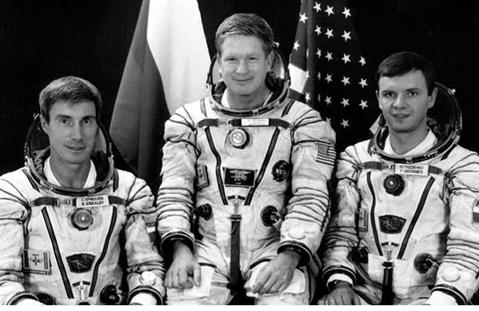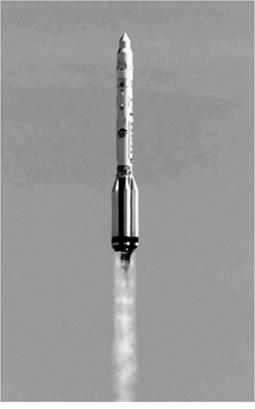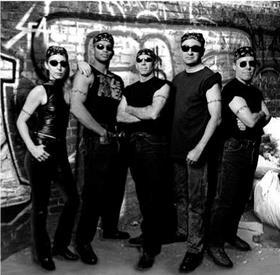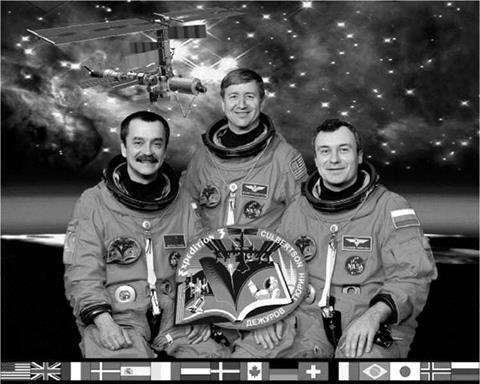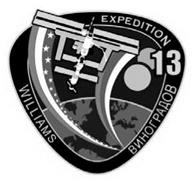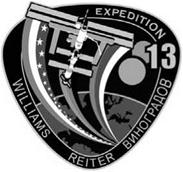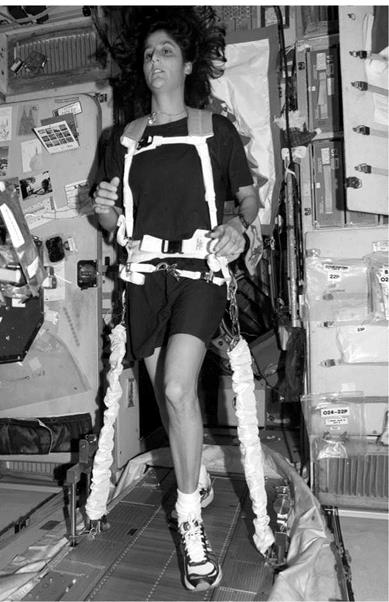The International Space Station… at last
Looking at NASA’s recent history of trying to build a space station, the casual viewer might think it a miracle that anything ever got off the ground, but this would be an unfair assessment. NASA did its best in an ever changing political world, both at home and abroad, and through several different presidencies and administrators. In some ways, the agency was its own worst enemy; its designs were always leading edge and therefore very expensive and time consuming to build, and therefore unlikely to be approved by Congress in times of financial constraint.
However, in 1998 the first hardware of the International Space Station (ISS) stood ready. After almost 14 years of political turmoil, numerous redesigns, and countless billions of dollars, NASA and its partners were finally ready to launch hardware into space. These first components were the Russian FGB, or Functional Cargo Block, called Zarya, which was a module that would give the early station attitude control, and the U. S. Node 1, or Unity, which was a connecting module to allow for further expansion of the station. Zarya, which was based on the TKS design from Chelomei’s design bureau back in 1969, was launched in November 1998 on a Russian Proton rocket, and was followed by the space shuttle Endeavour on mission STS-88 in December. The crew connected the two modules together, and carried out spacewalks to electrically link the modules, Sergei Krikalev was a mission specialist on this crew, as well as being a member of the planned first expedition. STS-96 followed in May 1999 with supplies for the first expedition, and carried out further spacewalks to “get ahead’’ before the Russian Service Module was launched.
January 2000 saw a seemingly unrelated meeting of Congress that created the Iran Non-Proliferation Act. In short this act disallowed any U. S. companies or organizations (including government agencies) from paying money to any country helping Iran with its nuclear program. Russia is one such country. On the face of it, this did not seem of any concern to the ISS program which was still early in its construction, and early too in its partnership with Russia. NASA already had a contract with Russia to provide 11 Soyuz and Progress spacecraft for crew rotation
|
Proton launching Zarya |
|
Expedition 1 crew |
and cargo delivery to the ISS that would last until April 2006. This contract was exempt from the new act as it had been agreed before the act’s creation. It surely would not become a problem later, because NASA planned to have its own Crew Return Vehicle in place by then, and the European Space Agency (ESA) was creating its own cargo delivery system (the Automated Transfer Vehicle) which was due to be ready before that date.
As the Service Modules’ delays increased, it was decided to fly another shuttle logistics mission, STS-101, in May 2000 to bring further supplies. The much delayed Service Module, Zvezda, was launched in July 2000, and docked with the orbiting Unity/Zarya combination. A Progress craft M1-3 docked at Zvezda’s rear port shortly after and replenished the fuel that had been used during the launch and docking procedures. The space shuttle Atlantis was launched in September on mission STS-106 to carry out the final outfitting of Zvezda prior to the arrival of Expedition 1; Atlantis also fired its engines to raise the orbit of the fledgling station. STS-92 launched in October with the first element of the truss assembly, and an additional docking port to be attached to the Unity module, and Discovery’s engines further raised the ISS orbit before it left.
Finally, the station was ready to receive its first crew. Soyuz-TM 31 was launched on 31 October 2000 carrying Soyuz commander Yuri Gidzenko, Expedition 1 commander William Shepherd and flight engineer Sergei Krikalev.
They docked with the station on 2 November, and entered shortly after. They were restricted to the two Russian modules initially, as there was not enough power
|
Proton launching Zvezda |
available to facilitate the use of Unity. The space shuttle Endeavour brought that additional power in the form of the first solar array truss, on the mission STS-97 in December 2000, and over the next few days the two huge solar arrays were deployed, and the internal and external connections made to enable the flow of power to the station.
The next major component of the ISS, the Destiny research laboratory, was launched aboard STS-98 on 7 February 2001 and connected to the station on the 10 February. Spacewalks were carried out to facilitate external connections between Destiny and Unity, and Atlantis raised the ISS orbit before leaving.
The Expedition 1 crew moved their Soyuz from the rear port of Zvezda to the downward or nadir (Earth-facing) port of Zarya, thus freeing the rear port for more Progress dockings. The first crew’s stay was nearly at an end, and when Discovery was launched on STS-102 with the Expedition 2 crew aboard it was time for NASA’s first crew rotation of the ISS program. The new crew consisted of commander Yuri Usachev, and flight engineers Susan Helms and James Voss. The rotation plan called for a rather complex one-at-a-time swap of crewmembers from ISS to the shuttle.
|
|
|
|
|
STS-98 crew in an unusual pose |
This routine was dropped on later crew rotation missions. STS-102 landed on the 21 March ending the first expedition to the ISS.
In April 2001 Endeavour was launched on mission STS-100, bringing the Canadian robotic arm to the station. The Canadarm-2 was vital to future station construction and operations, so this was an important mission; all was not to go smoothly, however. On the night of 24 April one of the command and control computers on board the ISS went offline unexpectedly, and the crew was woken to troubleshoot the problem, causing NASA to extend Endeavour’s mission by two days, and thereby conflicting with the upcoming first Soyuz “taxi” mission to replace the ISS Soyuz with a new one. The Russians agreed that the taxi Soyuz would be launched on time assuming that by the time it arrived at the station, the shuttle would be gone. If Endeavour was still there, as it was, then the Soyuz would remain in formation with the ISS. The Canadarm-2 passed its first tests successfully, but there were still lingering doubts over some of the computer systems on the ISS. However, Endeavour undocked and left the station on 29 April, leaving the way clear for
|
Expedition 3 crew |
Soyuz-TM 32, or EP-1 as the Russians called the mission. This mission was already controversial because of the inclusion of Dennis Tito, the first space tourist, on the crew. NASA argued that he was unqualified, especially on NASA systems, and therefore a danger to the station; the Russians countered that he was bringing valuable revenue to their space program, and therefore indispensable. It was finally agreed that Tito would limit himself to the Russian modules unless escorted by a U. S. crewmember; in reality Tito was happy to listen to music and gaze out of the windows in Zvezda during his six days aboard the station, but he did help out by preparing meals and doing odd jobs for the resident crew. Problems with the Canadarm-2 persisted, and the launch of the next shuttle mission was postponed, as it would require the use of the arm to install the first dedicated airlock module, called Quest, on the station. STS-104 was launched with the Quest airlock in July, and it was successfully installed without any major problems.
STS-105 followed in August with the next crew rotation, Expedition 3, commander Frank Culbertson, Soyuz commander Vladimir Dezhurov, and flight engineer Mikhail Tyurin. After all of the trials of the Phase 1 program, Culbertson made it back into space, eight years after his commanded shuttle mission STS-51. This crew would have the distinction of being the only humans in orbit during the 9/11 terrorist attacks, and it soon emerged that Culbertson had gone to flight school with the pilot of the airliner, Chic Burlingame, that hit the Pentagon. He wrote a letter home about the attack that was published on the NASA ISS website, in which he concluded “What a terrible loss, but I’m sure Chic was fighting bravely to the end. And tears don’t flow the same in space…’’
The next taxi mission, Soyuz-TM 33, arrived on the 23 October, carrying the crew of Viktor Afanasiev, flight engineer Konstantin Kazeev and French astronaut Claudie Haignere. This crew spent eight days on board the ISS, where Haignere performed experiments for ESA under the Andromeda program before the crew’s return in the older Soyuz-TM 32 spacecraft that had been docked to the ISS since the end of April.
STS-108 carried the Expedition 4 crew of commander Yuri Onufrienko and flight engineers Dan Bursch and Carl Walz to the station on the 7 December, and left on the 15 December. This crew had a fairly quiet time, apart from the failure of a wrist joint on the stations robot arm, and had not received any visitors until Atlantis arrived with a new segment for the truss element of the station in April 2002.
The third taxi mission, Soyuz-TM 34, docked on the 27 April, with the crew of Russian commander Yuri Gidzenko, and Italian researcher for ESA, Roberto Vittori. It also included the second space tourist in its crew. This time there was no controversy. South African Mark Shuttleworth had been completely trained on all aspects of station operations, both Russian and U. S., and had a scientific program to work through. This mission was to be the last launch of a Soyuz-TM spacecraft; the next launch would be the newer Soyuz-TMA version. Of course, the older Soyuz – TM 34 would remain docked to the ISS as the emergency crew return vehicle until it was replaced by the newer version. Again, the taxi crew spent eight days on board the station before leaving in the older Soyuz-TM 33 spacecraft on the 5 April.
In 2002 NASA canceled both the CRV (Crew Return Vehicle) and the ISS Habitation module. At a stroke this immediately reduced the maximum crew of the ISS to three, as this is obviously the number of crew that a Soyuz can carry. Without the Habitation module there would be nowhere for additional crew members to eat and sleep. By doing this, NASA broke several agreements with its International partners and created a great deal of ill feeling within the scientific community as it was fully realized that it took at least two crewmembers full-time just to keep the station running, this leaving barely one crewmember to carry out any science at all. Certainly it would not be possible for any international astronauts to now fly to the station to tend their own experiments, as there would be no room for them to live aboard, the station. The obvious choice in the short term would be to make use of more Russian Soyuz and Progress spacecraft, but this was not possible. All of a sudden the Iran Non-proliferation Act which had seemed unimportant a year ago was thrown into sharp relief. NASA could not buy anymore of anything from Russia without breaking the law. However, the end of that contract was still five years away, and the shuttle would be able to pick up any slack until then, wouldn’t it? In the meantime, NASA planned to go ahead with development of the Orbital Space Plane (OSP) concept, although this would not be ready until at least 2008.
I’m sure you are beginning to see a pattern forming by now. Every NASA plan would be first put on hold, and then canceled, to be replaced by something even more expensive, and even further into the reaches of time, after they had already spent way over their budget on the first project. The OSP project was canceled in 2004, and replaced by the new Crew Exploration Vehicle (CEV), of which, more later.
On 5 June 2002, STS-111 was launched with the Expedition 5 crew of Valery Korzun, Peggy Whitson, and Sergei Treschev. Whitson was flying in the newly created role of NASA Science Officer. This was seen as something of an appeasement to the science community, who argued that not enough science was being carried out on the ISS. When Endeavour landed ending the Expedition 4 mission, Bursch and Walz had set a new U. S. duration record of 195 days. During the mission of Expedition 5, the space shuttle fleet was temporarily grounded by the discovery of cracks in the hydrogen lines for the main engines. The problem was fixable, but delayed all subsequent shuttle missions. Therefore, it was not until October that Atlantis was launched on STS-112 with more components for the truss segment, plus supplies for the resident crew.
At the beginning of November, the next taxi mission, Soyuz-TMA 1, docked with the station, originally the EP-4 crew was to have included American singer Lance Bass, but not all of the money for his flight was forthcoming, and the Russians were strict. He was replaced by Russian cosmonaut Yuri Lonchakov. The rest of the crew consisted of commander Sergei Zalyotin, and ESA astronaut Frank De Winne of Belgium who would carry out a program of experiments for ESA. The taxi crew returned to Earth in Soyuz-TM 34, leaving the new Soyuz-TMA 1 for the resident crew.
STS-113 arrived at the station at the end of November 2002 with another truss segment, and the Expedition 6 crew. The new ISS crew included commander Ken Bowersox and flight engineers Don Pettit and Nikolai Budarin, with Pettit also taking on the role of NASA Science Officer. Budarin had flown twice before to the Mir space station, including a launch on the U. S. shuttle Atlantis on STS-71. Bowersox had flown on the U. S. shuttle four times previously; twice as pilot, and twice as commander. Pettit was making his first space flight on Expedition 6, replacing Don Thomas who had to stand down for medical reasons. The crew of STS-113 had also undergone a crew change when the original pilot Gus Loria was replaced by Paul Lockhart, who had just flown on STS-111, when Loria injured his back at home which caused him to miss too much training time. Both of these changes required new mission patches for both STS-113 and Expedition 6, which made the original STS – 113 patch with Loria and Thomas on it a rare item.
On the 1 February 2003 NASA’s worst nightmare scenario came to pass. The space shuttle Columbia was destroyed during re-entry, after a non-ISS scientific mission. The reasons for Columbia’s tragic loss have been well documented elsewhere and need not be repeated. However, the loss would have massive implications for the immediate future of the ISS, its future beyond April 2006, and indeed the future of NASA itself.
The big date that NASA had been aiming at for the last couple of years was 19 February 2004. This was the date that the station would be triumphantly proclaimed to be “U. S. Core Complete”, which was to say that certain key U. S. modules (including the important Node 2) would be connected to the station, and NASA could progress to fulfilling its promises to its international partners to launch their modules to the station. ESA and Japan in particular were keen to get their Columbus and Kibo (respectively) science modules launched and docked to the station after many delays.
Clearly, immediate changes to operations would need to be made, starting with the very next expedition. With Expedition 6 only just settled on the station, any changes were not urgent in nature, apart from the question of how best to get that crew home. Originally, they had been scheduled to be swapped with the Expedition 7 crew at that time consisting of commander Yuri Malenchenko, Sergei Moschenko and NASA’s Edward Lu, who would fly up on shuttle mission STS-114. However, changes to the personnel of Expedition 7 were taking place even before the Columbia accident. Sergei Moschenko was replaced by Aleksandr Kaleri, apparently because Moschenko’s English was not up to scratch.
On 1 April 2003, exactly two months after the Columbia accident, it was announced by NASA that the Expedition 7 crew would be reduced from three to two, and would consist of commander Malenchenko and NASA Science Officer and flight engineer Lu. Kaleri was bumped to back-up the flight of Expedition 7, and would later fly on board Expedition 8 with NASA’s Michael Foale in command. The reduction of crew from three to two would help to reduce the demands on the station’s food and water supply which would now only be replenished by Progress freighters, which could not carry anything like as much cargo as the shuttle. The crew rotations would now be carried out using the Soyuz-TMA spacecraft, which meant that the taxi missions were on hold for now, blocking a source of income for the Russians.
Therefore, on 26 April 2003 Soyuz-TMA 2 was launched with the two-man Expedition 7 crew of Malenchenko and Lu, replacing Bowersox, Pettit, and Budarin, who would return to Earth aboard Soyuz-TMA 1. Their return was not entirely straightforward, as the crew landed 460 km short of their target due to a computer error which commanded the capsule into a ballistic re-entry path, subjecting the crew to higher g loads than normal.
Soyuz-TMA 3 launched with the Expedition 8 crew of Foale and Kaleri in October 2003, with the Expedition 7 crew coming home in the older Soyuz-TMA 2. Foale now commanded a space station after his eventful flight aboard Mir. This expedition was trouble-free by comparison. This process was repeated in April 2004 with the launch of Soyuz-TMA 4 with the Expedition 9 crew of Gennady Padalka and Michael Fincke. The Expedition 10 crew of Leroy Chiao and Salizhan Sharipov were launched to the station on board Soyuz-TMA 5 on 14 October 2004. The pair stayed on board the ISS for 192 days and landed back on Earth on 24 April 2005 after enduring many ongoing problems with the station’s Elektron oxygen generating system. Sharipov attempted repairs for many days but the system was still offline and awaited the efforts of the Expedition 11 crew of Sergei Krikalev and John Philips.
On 26 July 2005 the space shuttle returned to flight after two and half years on the ground. The flight of STS-114 Discovery was a life saver to the ISS program as it relieved so many problems at once. The replacement CMG that had failed so long ago would be repaired, and the gathering rubbish and clutter on board the station would be greatly reduced by the Raffaelo module due to be delivered by Discovery which would also bring desperately needed new supplies including food and water. Following missions would restart the construction process. Unfortunately, that all fell flat after about a minute and a half of flight, when it became apparent that the fixes to the external tank (ET) of the shuttle were not all that NASA had hoped they would be. Newly installed cameras showed a large piece of foam from the ET falling away as the solid rocket boosters (SRB) separated. The chunk of foam missed Discovery, but it was quickly realized that it could have inflicted just as much damage as that visited upon Columbia two and a half years earlier. Although Discovery continued with her mission, the shuttle was once again grounded until further notice pending the solution to the foam problem. When Discovery reached the ISS it carried out a pre-planned pitch over maneuvre so that the crew on board the ISS could photograph Discovery’s underside to check for missing and/or damaged tiles. Unfortunately, many damaged tiles were discovered, seeming to prove beyond doubt that the external tank foam problem was just as bad as ever, and that re-grounding the shuttle was the right thing to do. The next shuttle mission, STS-121, was postponed until at least May 2006, after the deadline for NASA’s existing agreement with Russia for Soyuz had run out.
The Expedition 12 crew of Bill McArthur and Valery Tokarev were launched to the station on 1 October 2005 on board Soyuz-TMA 7 along with space tourist Greg Olsen. The new residents were relieved by Expedition 13 in March 2006. On 11 October 2005, Soyuz TMA-6 landed with the crew of Expedition 11, and space tourist Greg Olsen. Sergei Krikalev and John Philips had spent 179 days in space, and Krikalev was now the most travelled cosmonaut or astronaut in history with a grand total of 803 days in orbit from his two missions to Mir, two space shuttle flights, and two stays aboard the ISS.
On 26 October 2005, the House of Representatives came to NASA’s rescue when it voted to allow the space agency exemption from the Iran NonProliferation Act. This meant that they could buy Soyuz and Progress spacecraft from Russia until 2012. This allowed NASA to concentrate on finishing construction of the station without having to deliver new crews on the shuttle as well, and assured U. S. astronauts access to the ISS. All future crew rotations were to be carried out by the Soyuz craft, and cargo delivered by the Progress, with much heavier items being lifted into orbit by the shuttle once it finally returned to flight. Certainly this would prove to be much more cost effective for NASA as each Soyuz flight costs in the region of only $65 million, instead of at least $500 million for each shuttle launch.
The date 1 November 2005 marked an important day in the history of the ISS. The station had been continually occupied for 1,826 days, or 5 years. Since the first crew’s arrival, the ISS had grown considerably and now weighed 183 tonnes, with a habitable volume of 424m3; by comparison Skylab weighed 90 tonnes with a volume of 361 m3, and Russia’s Mir weighed 110 tonnes with a volume of 380 m3. There had been 97 visitors on board the station from 10 countries; and 29 had lived aboard as
|
|
|
Expedition 13 patch without and with Reiter’s name and German nag |
members of the 12 station expedition crews. Russian cosmonaut Sergei Krikalev was the only one so far to have served as a member of two resident crews.
On the 7 December 2005 the crew of Expedition 13 was announced, and consisted of station commander Pavel Vinogradov and U. S. astronaut Jeffrey Williams, they were to be joined on Soyuz TMA-8 by Brazilian Marco Pontes, who had trained at NASA as a mission specialist for a time until the agreement with Brazil for ISS components had been discontinued. He was to stay about one week.
It was not until July 2006 that STS-121 finally got off the ground, almost a year since the less-successful-than-hoped STS-114. This mission had originally been scheduled as a somewhat anti-climatic follow up to STS-114; it would simply repeat and revalidate most of the feats of the previous mission. It had not existed in the original pre-Columbia flight schedule, and had been added to reinforce the fact that the shuttle was once again safe to fly, hence its “out of sequence’’ numbering. However, after the failure of STS-114 to completely validate the new foam application process on the ET, the mission took on a new importance, rather than being just a follow-up, it would be an important milestone in proving the shuttle to be fit for purpose. It would also deliver a new crewmember to the ISS, bringing the permanent crew up to a full strength of three for the first time since Expedition 6. Thomas Reiter of the ESA would also be the first long-time crewmember from outside the U. S. or Russia.
The foam failures on STS-114 had come from an area of the tank that contained the attachment points for the SRBs, specifically, from an aerodynamic ramp in front of the attachments. NASA engineers had come to the conclusion that the best solution would be to remove those ramps completely, and remove the risk of foam shedding at the same time. However, these ramps had been previously thought to be essential aerodynamic aids for launch, and some were nervous about what effect their removal might have. On 4 July 2006, all worries were laid to rest when Discovery launched flawlessly into orbit with its crew of six, plus ISS crewmember Reiter. This time the ET performed perfectly, and no damage was seen on Discovery’s thermal protection system. The crew carried out the same checks as the flight of STS-114, and the same pitch-over maneuvre that was to be a part of all ISS docking approaches. Once docked at the station, the crew delivered more supplies, carried out two spacewalks to test future safety options, and made a few repairs on the ISS. The crew undocked, and landed on 17 July after leaving Thomas Reiter on the ISS to officially join the Expedition 13 crew.
The Expedition 14 crew consisted of U. S. commander Michael Lopez-Alegria, and two flight engineers, cosmonaut Mikhail Tyurin and astronaut Sunita Williams. The first two crew were launched on board Soyuz-TMA 9, whilst Williams flew to the ISS aboard STS-116 in December 2006. This continued the trend set by Thomas Reiter flying to the ISS aboard STS-121, the intention being to carry on the practice of sending the third crewman to the ISS aboard the shuttle to allow the Russians to sell the third seat on the Soyuz to potential researchers or tourists. In fact the format of the expedition crews was to change somewhat from Expedition 14 onwards. The crew size remained at three, but the third crewmember would change more frequently so that each expedition would have two or three different flight engineers, some from the partner nations such Japan, Canada, and ESA.
With the return of STS-121, NASA had renewed confidence in the shuttle’s abilities, and wanted to press on with the construction of the ISS. STS-115 with its crew of six was to add two pairs of new solar arrays to the ISS to provide power for the future Columbus and Kibo laboratories, and they would be supplemented by the crew of STS-117 in 2007. The space shuttle Atlantis was ready for its first space flight in four years, although not without some difficulty. A hurricane was due to hit the Kennedy Space Center whilst Atlantis was sitting on the pad, and the decision was taken to roll Atlantis back to the Vehicle Assembly Building (VAB), however, just as the shuttle was halfway back, the forecast changed and NASA managers decided to take Atlantis back to the pad after all. This was the first time in the shuttle’s history that such a move had been made. On 9 September 2006, Atlantis hurled herself into orbit to begin a 12-day construction mission. After the now standard checks of the shuttle tile system, which showed no damage at all, Atlantis docked with the ISS and prepared for the first of three spacewalks that would be carried out by this crew. First the new solar arrays, and the truss they are attached to, had to be lifted out the shuttle’s cargo bay using the shuttle’s robot arm and handed over to the station’s robot arm before they were attached to the station, this involved great precision and communication between Dan Burbank and Chris Ferguson, who were operating the shuttle’s arm, and Canadian Steve MacLean who was on board the ISS operating its
Canadarm-2. The new truss was left in the grasp of the stations arm until the next day, when spacewalkers Joe Tanner and Heidemarie Stefanyshyn-Piper removed the launch restraining bolts and began wiring the new arrays to the station after the truss was firmly attached to the existing structure. Steve MacLean and Dan Burbank continued the work on the flight’s second spacewalk, and the following Thursday the commands were sent to begin the unfurling of the new solar arrays. There were some concerns at this stage that the arrays might stick (they had, after all, been packed in their storage box for over three years due to the delays in the shuttle program) but they deployed perfectly to their full length of 240 ft. A third spacewalk by Tanner and Stefanyshyn-Piper completed the work by removing the last restraints that allowed a radiator to unfurl, and also upgraded the stations communications system. STS-115 had been an outstanding success, but it was not without its little last minute drama. Two days after undocking from the ISS, as the crew prepared for reentry, a small object was observed by ground radar floating just below the shuttle’s belly. They immediately postponed the planned de-orbit burn to give them time to diagnose this discovery. The next day permission for re-entry was given after the crew had carried out another check of the thermal protection system with the shuttle arm and boom; it was later decided that the object was almost certainly a plastic tile gap filer, and that the other smaller bits of debris probably came from the cargo bay, and were a result of Atlantis’ prolonged down time between flights.
One more flight remained in 2006; the December launch of STS-116 with the shuttle Discovery. The crew of seven contained five rookies, amongst them Sunita Williams, who was to become the second new member of the Expedition 14 crew on the ISS. She would remain on board for the next six months, crossing over the period when Expedition 15 took over command of the station. ISS resident Thomas Reiter would be brought back to Earth after his long stay on the ISS that began with the launch of STS-121. There were more criteria for Discovery’s launch than previous missions, mostly due to the time of year; NASA did not want the shuttle to still be in orbit during the New Year crossover, as it was felt that the on board computers may have a hard time dealing with the new date. A second consideration were the orbital thermal conditions during December which made it preferable to launch between 7 and 26 December, because the shuttle must launch as the ISS passes into the correct orbital plane for the shuttle’s ascent path, this dictated a night-time launch, the first since the Columbia accident. Night launches had been ruled out by the safety commission due to the needs of ground-based photography to inspect the shuttles tiles and ET during launch; however, NASA felt that the last two missions had provided enough confidence over the launch performance of the redesigned ET to allow this requirement to be waived. Lastly, an engine firing by the docked Progress freighter was required to boost the ISS orbit enough to allow a docking on flight day three of the mission regardless of the day of launch. The first attempt at this firing had failed, possibly due to the station’s unbalanced current configuration, but a second attempt, carried out a week later with a software patch to compensate for the station’s off-axis center of mass, was successful and allowed Discovery’s countdown to begin as scheduled. Unfortunately, the first launch attempt was scrubbed due to unacceptable weather at the launch site. The second try was scheduled two days later, as the weather forecast for a 24-hour turnround were thought unlikely to be any better. On Saturday 9 December, mission STS-116 got underway despite the weather looking to be uncooperative for most of the countdown. The spectacular light show put on by the shuttle’s main engines and SRBs was enough for some of the launch photography to be carried out, but in fact such pictures were not really necessary, as the launch proceeded flawlessly, and as Shuttle Program Manager Wayne Hale said, “We’re not relying on those ascent-based observations for the safety of that particular flight, we’re relying on the inspection of the heat shield, which we do in excruciating detail on orbit now to make sure they’re safe to come back.’’ On flight day three, as scheduled, Discovery docked with the ISS and immediately the crew set to work, Sunita Williams installed her seat liner in the docked Soyuz for use in an emergency evacuation of the station, and at that moment became an official member of the Expedition 14 crew. Thomas Reiter, had until that moment, been part of the resident crew, but now joined the STS-116 crew in preparation for his return to Earth. Rookie mission specialist Nicholas Patrick, born in England, hoisted the new solar array truss out of the payload bay and handed it over to the ISS robot arm operated by Sunita Williams, where it would wait until the next day and the first of the planned Extravehicular Activities (EVAs). The first EVA was to be carried out by veteran space walker Robert Curbeam and his partner Rookie Swedish astronaut Christer Fuglesang. They successfully installed the new segment of truss on the end of it’s existing length. The first EVA was so trouble-free that they were able to tackle a couple of tasks from the next EVAs schedule in order to ensure that the mission kept ahead of the timeline in case something unexpected happened later in the mission. Something unexpected duly did occur the very next day, when ground controllers attempted to fold up one of the existing solar arrays to allow them to be moved during a later mission, and also to allow enough clearance for the adjacent arrays installed during STS-115 to begin to rotate to track the Sun. The array refused to fold up by the required amount, getting stuck after only about half of its length had been retracted. Ground controllers decided to press ahead with the rest of the mission’s EVAs whilst they worked on possible solutions. Curbeam and Fuglesang carried out a second EVA to rewire the station’s power supply in readiness for more solar arrays; so successful were their efforts that the spacewalk ended an hour early. The third EVA, which was to feature ISS resident Sunita Williams’ first EVA with Curbeam, continued with the rewiring efforts and also reconfigured some of the station’s cooling systems as well. Ground controllers had decided to add a task to this EVA, if there was time, to get the spacewalkers to look at the stuck solar array and try to provide more information on the problem, and if time allowed, carry out repair efforts. The spacewalking crew managed to coax the array further into its box, but a stubborn part on one side of the array stopped further progress as the astronauts’ time for this spacewalk had run out. Ground controllers decided to add a fourth EVA to the already crowded flight plan for the very next day, that they hoped would finally put the array back in its box. However, the extra time needed for an additional EVA did not come without a price. The crew would have to sacrifice a planned contingency landing day, which would mean that Discovery would have less time to play with in the event of unacceptable weather at the primary landing sites at the Kennedy Space
Center (KSC), Edwards Air Force Base, or Nothrup Strip at White Sands in New Mexico. The White Sands landing site has only ever been used once in the shuttle’s history, at the end of Columbia’s third test flight; engineers on the ground say that it took years to get all of the gypsum out of Columbia’s nooks and crannies. The fourth EVA proved to be successful when Curbeam managed to coax the last of the array into its box. This prepared the way for the crew of STS-120 which will fly toward the end of 2007, to relocate the array to the other end of the station. Discovery undocked from the ISS the next day and began preparations for its return to Earth. Commander Mark Polansky said, “It’s always a goal to try and leave some place in better shape than it was when you came and I think we’ve accomplished that due to everyone’s hard work. And so with that, I hope we’re really on our way to a great start for assembly completion.’’ Discovery and her crew attempted to land at the first opportunity, but were waived off when the weather at both KSC and Edwards became unacceptable; they would have to wait another orbit (an hour and a half) before they could try again. Then, with minutes to go, KSC’s weather decided to co-operate, just, and the crew were given a “go” to carry out the de-orbit burn, Discovery completed the mission after nearly 13 days with a smooth touchdown on KSC’s concrete runway ending STS-116 and the long-duration mission of some six months for Thomas Reiter.
The year 2006 had been a successful one for NASA and its ISS partners. STS-116 had added more power to the station, and the stage was set for the next shuttle flight, STS-117, to finish that work. Atlantis was due for launch on 15 March after being rolled out to the pad on 15 February and everything appeared to be on schedule to meet that launch date, when on 26 February a freak hailstorm tore through the Kennedy Space Center causing damage to the exposed nose of the external tank. At first it was hoped that the damage would not be too bad, and that repairs could be carried out at the pad, but inspection revealed at least 1,000 points of damage, additional damage was found on Atlantis’ left wing and a rollback to the Vehicle Assembly Building (VAB) was essential. When the shuttle got back to the VAB and close inspections were possible it was finally determined that there were 2,644 points of damage. The repair effort was clearly going to take some time, and the launch schedule for the year was now under threat. The original launch schedule had called for STS-117/Atlantis to be launched mid-March, followed by STS-118/Endeavour in June, and STS-120/Atlantis in September, with STS-122/Discovery rounding out the year in November. The turnaround of Atlantis after STS-117 for launch again on STS-120 would also have been very difficult in such a short timescale. On the 16 April, NASA announced a new flight schedule which still allowed four missions to the ISS in 2007. The complete schedule can be found in more detail in Appendix A, but the summary is:
STS-117/Atlantis (8 June 2007)
STS-118/Endeavour (9 August 2007)
STS-120/Discovery (20 October 2007)
STS-122/Atlantis (6 December)
STS-123/Endeavour (14 February 2008)
STS – 124/Discovery (24 April 2008)
STS – 119/Endeavour (10 July 2008)
NASA was not having a very good start to year in other respects as well. A great deal of unwanted media interest was focused on the space agency when astronaut Lisa Nowak, who had flown on STS-121, was arrested on 5 February. It was alleged that Nowak, a U. S. Navy Captain, had tried to kidnap her perceived rival for the attentions of fellow astronaut, U. S. Navy Commander Bill Oefelein. Oefelein has just recently returned from his first spaceflight as pilot on STS-116 in December last year. The court case is not due to take place for some months but NASA relieved Nowak of her duties at the Johnson Space Center, and returned her to the Navy, stating that the Navy were better equipped to deal with this case than NASA.
Better news came on 7 April, when the Expedition 15 crew of Fyodor Yurchikhin and Oleg Kotov, along with space tourist Charles Simonyi were launched successfully to the ISS. Simonyi is the fifth space tourist to fly by virtue of an agreement with Space Adventures Ltd. Simonyi is best known as being the man behind software applications such as Word and Excel. Commander Fyodor Yurchikhin and flight engineer Oleg Kotov will replace Expedition 14 commander Michael Lopez-Alegria and flight engineer Mikhail Tyurin, the third ISS crewmember Sunita Williams will remain on board until she is replaced by Clay Anderson. On 2 April, Lopez-Alegria became the longest flying U. S. astronaut when he broke the existing record set by Expedition 4 of 196 days, however, this record may be broken by Sunita Williams if she still returns to Earth on board STS-118/Endeavour which is now delayed until August 2007. After the change in the space shuttle’s launch schedule, some thought was being given within NASA to returning Williams on STS-117 in June rather than waiting for STS-118. At the time of writing no final decision had been reached. Even if she does not break the endurance record, Sunita has already broken a record of a different kind when she took part in the Boston marathon on 16 April. She was an official participant running on the stations treadmill whilst fellow astronaut Karen Nyberg took part on the ground. Running on the treadmill is an important part of any astronauts exercise regime whilst on a long-duration mission, and Williams, who is an accomplished marathon runner, had been training for this run for most of her flight so far. She finished the “course’’ in 4 hours, 23 minutes, and 10 seconds.
In the remainder of 2007 it is important to NASA’s schedule to complete the ISS, with several missions adding essential parts to the station. STS-117 will add more solar arrays—extra power that is essential to the new modules that are due to be delivered over the next two years. STS-118 will add another segment of the station’s truss structure. In addition it will see the flight of Barbara Morgan, Christa McAuliffe’s back-up for the tragic STS-51L Teacher in Space mission. STS-120 adds another vital component to the growth of the ISS when it launches with Node 2, now called Harmony. Harmony will serve the same purpose as Unity currently does, as an interconnecting module for future labs such as Columbus and Kibo. STS-122 will take the long awaited European Space Agency lab, Columbus, to the station, before
|
Sunita Williams running on treadmill |
2008 when STS-123 and STS-124 will attach the various parts of Japan’s Kibo lab to the station. Beyond that will be the installation of Node 3, more solar arrays and truss segments, before the ISS is declared complete (see color plates for the complete ISS assembly sequence).












